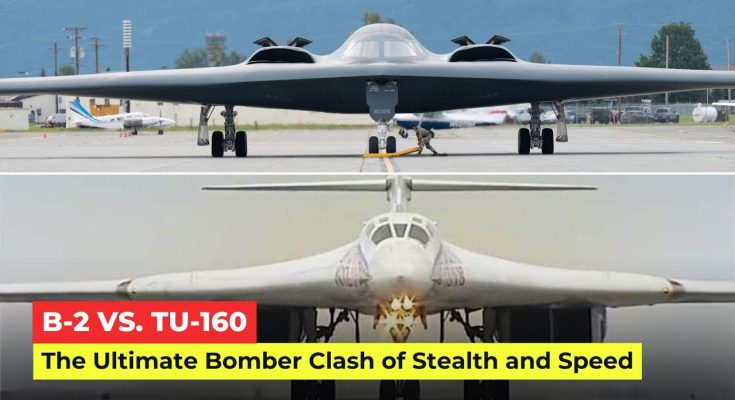The battle between two of the world’s most formidable strategic bombers—the B-2 Spirit from the United States and the Tu-160 Blackjack from Russia—represents a stunning contrast in design philosophy, capabilities, and strategic roles. These heavyweights in the skies are built for different purposes, but both embody cutting-edge technology and have shaped the landscape of modern aerial warfare. The B-2 Spirit is renowned for its stealth capabilities, while the Tu-160 is a showcase of speed and sheer firepower. In a Bomber Showdown between stealth and speed, the question arises: Which is the ultimate weapon in modern warfare?
The B-2 Spirit: Stealth Over Speed
The B-2 Spirit, often called the “Stealth Bomber”, was developed by Northrop Grumman to perform long-range, high-precision strikes while remaining virtually undetectable to enemy radar. Its flying-wing design is a defining feature, minimizing its radar cross-section and making it difficult to detect by even the most advanced radar systems. The B-2 was crafted with one primary purpose: to penetrate heavily defended airspace and deliver nuclear or conventional payloads with minimal risk of interception.
The B-2’s ability to avoid enemy detection is what truly sets it apart. By flying at low altitudes and using its stealth technology, the B-2 can strike high-value targets without being seen or tracked by enemy radar, making it incredibly effective in suppressing enemy defenses. It can carry a wide variety of weapons, including precision-guided bombs, and has the ability to deliver nuclear payloads as well. However, its top speed is somewhat modest—only capable of reaching Mach 0.95, just under the speed of sound.
While the B-2’s speed is far from the fastest in the skies, its stealth allows it to remain undetected for long periods, giving it the element of surprise. This combination of low visibility and precision strike capabilities allows the B-2 to infiltrate enemy airspace and take out critical infrastructure, making it a strategic asset in the U.S. Air Force’s arsenal.
The Tu-160 Blackjack: Speed and Firepower
In contrast to the B-2’s stealthy approach, the Tu-160 Blackjack—also known as the “White Swan”—is designed with a focus on speed and payload capacity. Developed by the Soviet Union and now operated by Russia, the Tu-160 is the largest and heaviest supersonic bomber ever built, capable of reaching speeds of up to Mach 2.05, more than twice the speed of sound. This incredible speed allows the Tu-160 to outpace interception by most adversary fighters, especially in long-range strike missions.
The Tu-160’s sheer power is another major factor in its dominance. It can carry a staggering payload of up to 40 tons, including both conventional and nuclear weapons, and has the ability to launch cruise missiles from long distances. This makes it a critical asset for both strategic deterrence and conventional warfare.
The Tu-160’s speed and range also give it an edge in certain scenarios. Its ability to cover vast distances quickly allows it to strike high-value targets deep in enemy territory, all while evading interception through sheer velocity. It relies on its speed and advanced electronic countermeasures to evade enemy radar systems, making it a powerful tool in the event of a high-intensity conflict.
Stealth vs. Speed: The Bomber Showdown
In a head-to-head battle between the B-2 Spirit and the Tu-160 Blackjack, the clash would come down to the priorities of the mission. The B-2’s stealth gives it the advantage when it comes to penetrating heavily defended airspace and striking targets with precision while avoiding detection. Its ability to operate undetected in hostile territory would make it extremely difficult for the Tu-160 to successfully target it, especially in an environment where radar-guided missiles and advanced air defenses are active.
On the other hand, the Tu-160’s speed offers a distinct advantage in scenarios where rapid, long-range strikes are necessary. The Blackjack’s supersonic capabilities would allow it to quickly deliver its payload to deep targets, such as enemy military infrastructure or command centers, before enemy forces can react. Its ability to outrun interception systems makes it a formidable asset in fast-paced, high-stakes situations where time is of the essence.
However, in a scenario where air defenses are less advanced, the Tu-160’s raw speed could allow it to reach targets more quickly, but the B-2’s stealth and precision strike capabilities would likely enable it to execute a successful strike without being detected. Ultimately, the success of either aircraft in such a showdown would depend heavily on the environment and the nature of the mission.
Conclusion: The Ultimate Bomber
The B-2 Spirit and Tu-160 Blackjack are both incredibly advanced aircraft, each with unique advantages. The B-2’s stealth gives it an edge in covert operations and precision strikes against high-value targets in heavily defended airspace, while the Tu-160’s speed and firepower make it a formidable adversary in scenarios that demand rapid response and long-range strikes.
In terms of sheer tactical versatility, the B-2’s stealth and precision make it more adaptable for covert operations, while the Tu-160 excels when it comes to raw speed and payload capacity. Ultimately, the choice between these two bombers would come down to mission requirements: stealth and precision for the B-2, or speed and power for the Tu-160.
While both bombers represent their nations’ strategic prowess, the Bomber Showdown between the B-2 Spirit and the Tu-160 Blackjack is a fascinating reflection of the balance between stealth and speed in modern aerial warfare. Each aircraft holds a key role in the ever-evolving landscape of military aviation.



